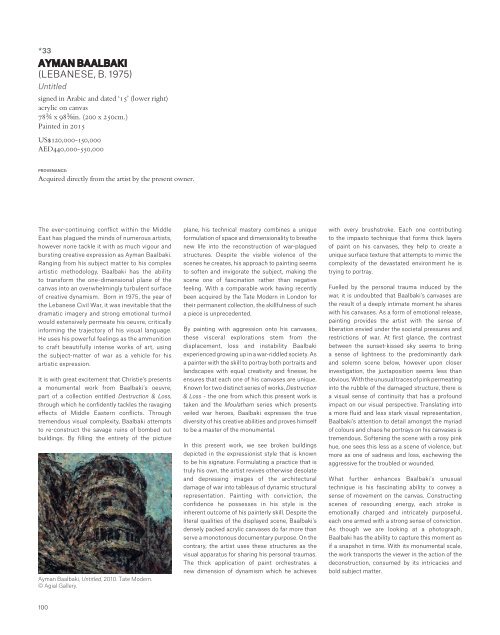NOW AND TEN
DUB1241_SaleCat
DUB1241_SaleCat
You also want an ePaper? Increase the reach of your titles
YUMPU automatically turns print PDFs into web optimized ePapers that Google loves.
*33<br />
AYMAN BAALBAKI<br />
(LEBANESE, B. 1975)<br />
Untitled<br />
signed in Arabic and dated ‘15’ (lower right)<br />
acrylic on canvas<br />
78æ x 98¡in. (200 x 250cm.)<br />
Painted in 2015<br />
US$120,000-150,000<br />
AED440,000-550,000<br />
PROVENANCE:<br />
Acquired directly from the artist by the present owner.<br />
The ever-continuing confict within the Middle<br />
East has plagued the minds of numerous artists,<br />
however none tackle it with as much vigour and<br />
bursting creative expression as Ayman Baalbaki.<br />
Ranging from his subject matter to his complex<br />
artistic methodology, Baalbaki has the ability<br />
to transform the one-dimensional plane of the<br />
canvas into an overwhelmingly turbulent surface<br />
of creative dynamism. Born in 1975, the year of<br />
the Lebanese Civil War, it was inevitable that the<br />
dramatic imagery and strong emotional turmoil<br />
would extensively permeate his oeuvre, critically<br />
informing the trajectory of his visual language.<br />
He uses his powerful feelings as the ammunition<br />
to craft beautifully intense works of art, using<br />
the subject-matter of war as a vehicle for his<br />
artistic expression.<br />
It is with great excitement that Christie’s presents<br />
a monumental work from Baalbaki’s oeuvre,<br />
part of a collection entitled Destruction & Loss,<br />
through which he confdently tackles the ravaging<br />
efects of Middle Eastern conficts. Through<br />
tremendous visual complexity, Baalbaki attempts<br />
to re-construct the savage ruins of bombed out<br />
buildings. By flling the entirety of the picture<br />
Ayman Baalbaki, Untitled, 2010. Tate Modern.<br />
© Agial Gallery.<br />
plane, his technical mastery combines a unique<br />
formulation of space and dimensionality to breathe<br />
new life into the reconstruction of war-plagued<br />
structures. Despite the visible violence of the<br />
scenes he creates, his approach to painting seems<br />
to soften and invigorate the subject, making the<br />
scene one of fascination rather than negative<br />
feeling. With a comparable work having recently<br />
been acquired by the Tate Modern in London for<br />
their permanent collection, the skillfulness of such<br />
a piece is unprecedented.<br />
By painting with aggression onto his canvases,<br />
these visceral explorations stem from the<br />
displacement, loss and instability Baalbaki<br />
experienced growing up in a war-riddled society. As<br />
a painter with the skill to portray both portraits and<br />
landscapes with equal creativity and fnesse, he<br />
ensures that each one of his canvases are unique.<br />
Known for two distinct series of works, Destruction<br />
& Loss - the one from which this present work is<br />
taken and the Moulatham series which presents<br />
veiled war heroes, Baalbaki expresses the true<br />
diversity of his creative abilities and proves himself<br />
to be a master of the monumental.<br />
In this present work, we see broken buildings<br />
depicted in the expressionist style that is known<br />
to be his signature. Formulating a practice that is<br />
truly his own, the artist revives otherwise desolate<br />
and depressing images of the architectural<br />
damage of war into tableaus of dynamic structural<br />
representation. Painting with conviction, the<br />
confdence he possesses in his style is the<br />
inherent outcome of his painterly skill. Despite the<br />
literal qualities of the displayed scene, Baalbaki’s<br />
densely packed acrylic canvases do far more than<br />
serve a monotonous documentary purpose. On the<br />
contrary, the artist uses these structures as the<br />
visual apparatus for sharing his personal traumas.<br />
The thick application of paint orchestrates a<br />
new dimension of dynamism which he achieves<br />
with every brushstroke. Each one contributing<br />
to the impasto technique that forms thick layers<br />
of paint on his canvases, they help to create a<br />
unique surface texture that attempts to mimic the<br />
complexity of the devastated environment he is<br />
trying to portray.<br />
Fuelled by the personal trauma induced by the<br />
war, it is undoubted that Baalbaki’s canvases are<br />
the result of a deeply intimate moment he shares<br />
with his canvases. As a form of emotional release,<br />
painting provides the artist with the sense of<br />
liberation envied under the societal pressures and<br />
restrictions of war. At frst glance, the contrast<br />
between the sunset-kissed sky seems to bring<br />
a sense of lightness to the predominantly dark<br />
and solemn scene below, however upon closer<br />
investigation, the juxtaposition seems less than<br />
obvious. With the unusual traces of pink permeating<br />
into the rubble of the damaged structure, there is<br />
a visual sense of continuity that has a profound<br />
impact on our visual perspective. Translating into<br />
a more fuid and less stark visual representation,<br />
Baalbaki’s attention to detail amongst the myriad<br />
of colours and chaos he portrays on his canvases is<br />
tremendous. Softening the scene with a rosy pink<br />
hue, one sees this less as a scene of violence, but<br />
more as one of sadness and loss, eschewing the<br />
aggressive for the troubled or wounded.<br />
What further enhances Baalbaki’s unusual<br />
technique is his fascinating ability to convey a<br />
sense of movement on the canvas. Constructing<br />
scenes of resounding energy, each stroke is<br />
emotionally charged and intricately purposeful,<br />
each one armed with a strong sense of conviction.<br />
As though we are looking at a photograph,<br />
Baalbaki has the ability to capture this moment as<br />
if a snapshot in time. With its monumental scale,<br />
the work transports the viewer in the action of the<br />
deconstruction, consumed by its intricacies and<br />
bold subject matter.<br />
100


